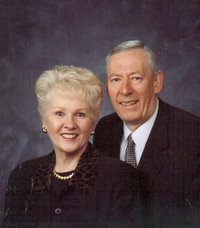The Masai Mara Adventure
Robert D. & Janet L. Taylor
August 2008
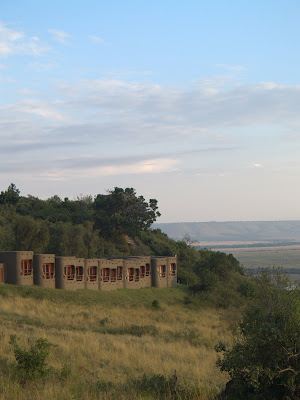
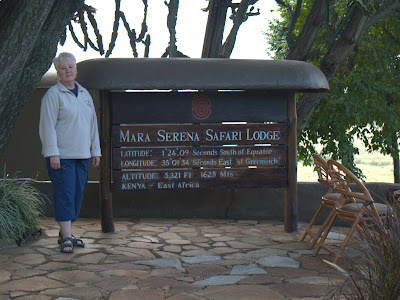
The day started out like any other in the untamed bush of the Masai Mara Game Reserve in Kenya Africa. After morning ablutions, we had a leisurely breakfast sitting on top of a small mountain at the Mara Serena Lodge. Even though we are only one degree latitude below the equator the weather is quite pleasant, the lodge is at 5300 feet above sea level and it is the rainy season. The temperature is in the mid 70's. Definitely it is sandals, shorts and short sleeve weather. Sitting in the lodge restaurant and looking down over the savannah is almost like viewing the valley from a small airplane. There are herds upon herds of different animals spread profusely through the valley, as far as the eye can see; elephant, giraffe, wildebeest (gnu), zebra and wildebeest and zebra and wildebeest, wildebeest and wildebeest. Oh, and did I mention wildebeest?
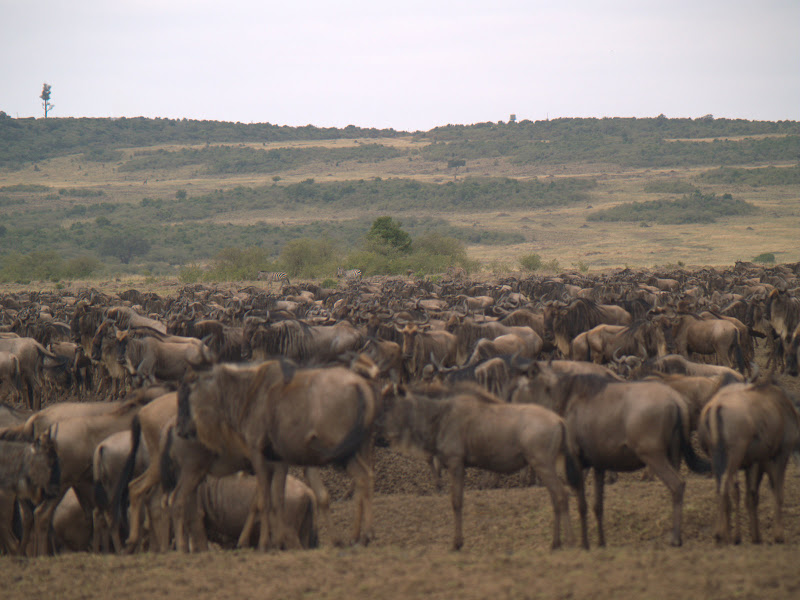
Zoologists estimate that the great migration includes 1.3 million wildebeest, 600,000 zebra and about 300,000 antelope of different varieties. This area has the largest concentration of predators with an estimate of over 500 lions. The Mara River has innumerable hippos and crocodiles. The Mara Crocodile is the largest crocodile in the world. Another key statistic is that the wildebeest alone, will deposit over 60,000 tons of dung to fertilize the grasslands for the next migration.
The park has only a few rules, of which I will quote several of the key ones.
- You may only be on the roads and tracks between 6:00am and 7:00pm
- Stay in your vehicle, especially in the presence of animals
- Try to avoid breakdowns. Take some food and plenty of water for you and the vehicle
- Travel in groups of two or more vehicles if possible
- Be especially sensible in wet weather when most tracks and some roads will be impassable
- If you are an independent traveler and you are going "off the beaten track", let someone know where you are going. Cell phones do not yet generally function in the Mara
- If you break down stay with your vehicle. Walking for help may mean that no-one ever finds you! Sit tight and you will be eventually picked up.
For this day we had one major goal: to witness migration herds swim across the crocodile infested Mara River.
We started by driving our Nissan Hardbody truck with differential-lock down to the river just east of the lodge. The truck had been loaned to us for our time in Kenya by the Church's Kenya Regional Office. We meandered along the river following tracks made by safari trucks. The first place we stopped we got out of the truck and stood on the embankment so we could better see the pods of hippos and lounging crocodiles. These are big crocodiles 10-12 feet long with a tremendous girth that you could not wrap your arms around, assuming that you might be silly enough to try!
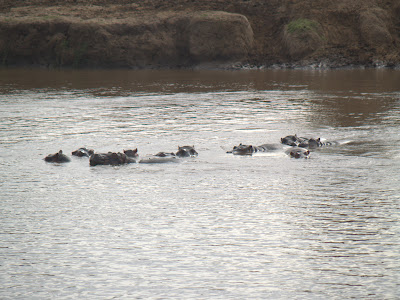
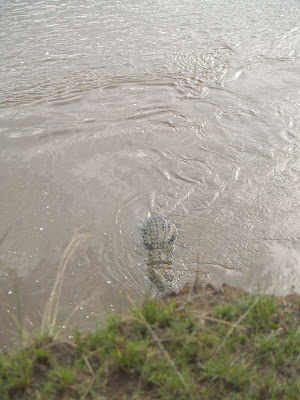

We drove further along the river the river and I got my first heart attack of the day. Jan decides to get out of the truck again and stand very close to the edge of the embankment about 15 feet above the dozing monstrous crocodiles. What Jan couldn't see but I could was that she was standing on an edge that had been undercut by earlier flood waters. I expected the edge to break away and her fall to the water's edge. I am sure that she would have survived the fall but the crocs would have made a quick snack of "the white imported American food". After I gave her a severe tongue lashing (see rule number 2 above), we proceeded to the part of the river where the zebra and wildebeest were congregating to cross the river. We stopped a few hundred yards short of the river finding ourselves surrounded by thousands and thousands of animals (without exaggeration).
At this point Jan wanted to take pictures of the swirling masses around us and that's when we discovered that we could not find her camera. It was not in the truck and that's when we realized that it must have fallen out during one of our previous stops. Panicked we picked our way back through the animals and went to where we had started along the river. Just as we approached our first stopping point Jan noticed too late the camera on the ground, just as the front tire of the truck ran over it! Amazingly it wasn't crushed to pieces just pushed into the soft mud and grass. We found the viewing plate broken but otherwise operational. Hopefully, it can be repaired. It has been such a great compact camera being able to take excellent still photos as well as video.
Crestfallen about the camera, we made our way back to the crossing site and were able to find a really good viewing point. This, in spite of the fact, that there were many safari trucks from various camps vying for the best spots.
Our luck was changing just as we got into position the first migration across the river started. The animals cross from the southern plains, north into the grassy plains of the Masai Mara where they will stay until October. This clockwise circular migration occurs every year as the herds follow the rains and the ensuing rich grasses. From the Masai Mara the herds move south and east into Tanzania and the Serengeti plains.
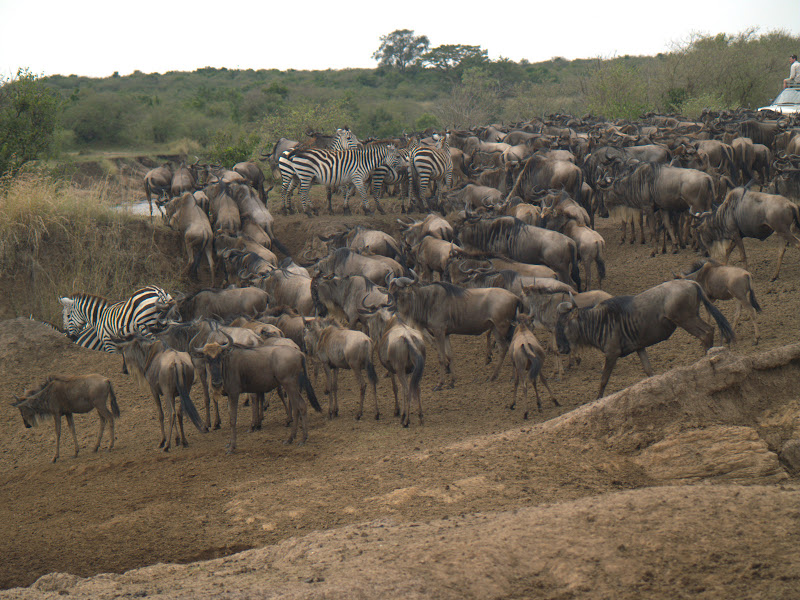
At this point we had achieved our goal for the day! We watched two giant herds swim the river and climb the bank on the far side. The crocs were apparently full from previous herds because there were no attacks while we watched. We learned something interesting from watching. Even though there are thousands of wildebeest and zebra waiting to cross they don't do it en masse. They seem to cross in individual herds of hundreds. Another interesting thing is that they don't just walk to the bank and start swimming. There is a lot of pondering and positioning waiting for a brave leader to make the first move. Once one starts the swim everyone crowds to the edge of the river to follow. They swim across in lines much like ants following one another. There may be one line or several lines but they swim in lines rather than as a swarm.
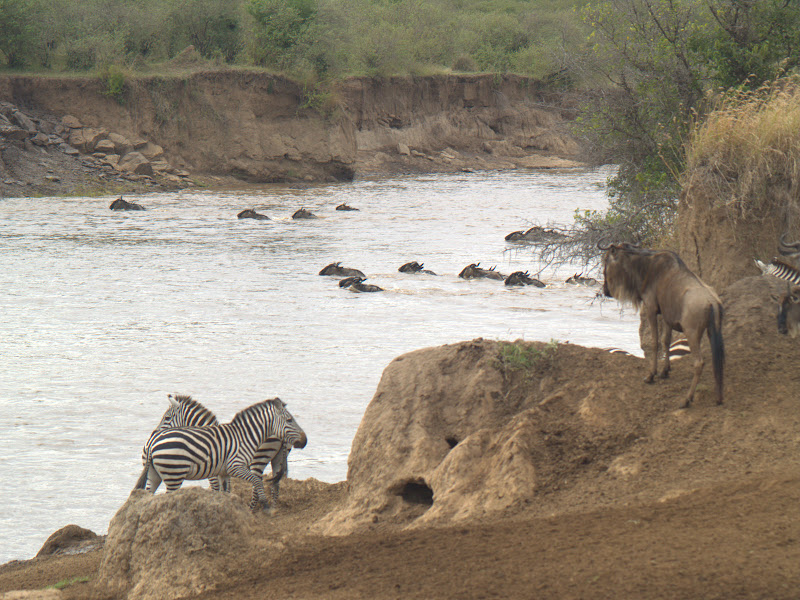
After watching and filming the crossing of two different herds it was time to head back to the lodge for lunch and a comfort break.
For the afternoon we decided we wanted to try and find a cheetah. We started driving aimlessly west along the river following unmarked trails and dirt "so-called" roads. I might mention here that there are no signs whatever in this reserve. You pretty much have to be mindful of where you're going in relation to finding your way back to the lodge.
About 4:00pm we saw a landie (Land Rover) leave the road and start to climb up the side of the escarpment. This usually means that they have an idea where a cheetah, lion or leopard may have been previously spotted. We watched them climb utilizing our field glasses. They stopped high on the hill about a mile from where we were stopped. We decided to follow and see what they had found. There were vultures around a kill about halfway up. We continued on up to find out that they were only taking pictures of the valley below. We travelled an additional ¼ mile up the hill. I then also got out and started taking pictures until Jan noticed that they had two gun bearers with them. I quickly got back in the car. We didn't have a gun bearer!
As we were heading down the mountain we remarked how thrilling it was to be 4-wheeling on unmarked trails in the Kenyan bush surrounded by wild animals.
We arrived back on a road that would take us to the lodge. Not too far along we noticed a couple of safari trucks heading off-road towards the river. We followed. Because of the previous rains the trails had many mud holes and deep ruts. We trudged on through and found some safari trucks near two groups of lions.
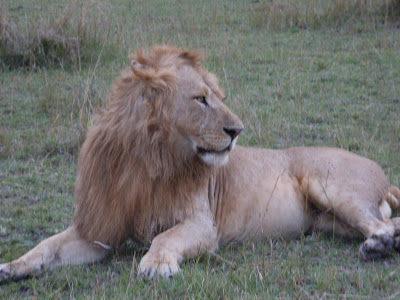
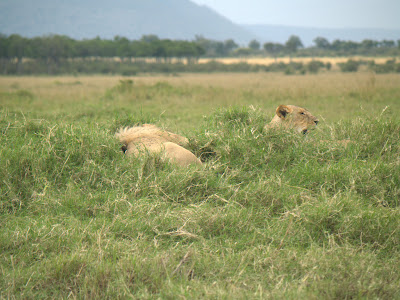
We didn't stay too long because it was getting late and we were a long trek back to the lodge. About ½ mile from the lions, we encountered a monstrous mud hole that I knew that without 4-wheel drive and just our diff-lock there was no way we would make it through. There was another trail around the hole through the trees that others had used to by-pass the mud. I didn't scout it out first. Who wants to walk through trees knowing there are lions around? We headed for the by-pass. Once committed it was too late to turn back. I tried to remember that momentum was my friend and speed my enemy! Once viewed, we realized that the by-pass was every bit as bad as the hole that we had avoided. Two-thirds of the way through the truck totally bogged down, sunk in the mud right up to the axles. Couldn't go forward – couldn't go backward and here we were in heart of lion country miles from nowhere. There was nothing to do but try to extricate ourselves. We had no mud jacks – no shovel – the next best thing – start tearing apart trees with our bear hands to try and fill the ruts in the mud with a base that the wheels could get a grip on. There was fear, exasperation, heavy breathing by two old people from the exertion of such heavy, hard work. I kept getting in and trying to drive the truck. Rocking back and forth, crunching the gears and clutch from first gear to reverse and back again. Nothing! We were going nowhere! It was now after 6:00pm and it gets dark at 6:30pm. What to do? We took a break for a much needed vocal prayer together seeking some inspiration. We knew that if we didn't want to spend the night in the bush that we were going to need some divine intervention. And with the fear of the lions haunting us, we faced an even more persistent foe attacking us from all sides – mosquitoes! Can you say "malaria"?
More branches under the wheels – more rocking but still nothing! We were stuck. It really looked like a long night in the truck deep in the Kenyan bush. We tried our cell phone and it worked. This was the start of small miracles! We called our contact 6 hours away in Nairobi. We asked him to call the lodge to see if they could help us. We didn't know where we were, except that we were maybe 20 kilometers south west of the lodge near a pride of lions. How was anyone going to find us after dark?
I made a unilateral instant decision. I had to try and get help. I ran back 200-300 yards towards the lions. Jan is screaming and crying at me to come back to the truck. But sometimes a "man has to do what a man has to do" to protect his family. Fortunately two safari trucks were still watching the lions. I started screaming "help" at the top of my voice and waving my arms. One truck started up and headed away from where we were. More shouting! More arm waving! There was only one truck left. It started up and started moving to our right. I was sure it couldn't hear or see me either. The light was dim and the diesel trucks drown out faint noises. Finally they turned and started heading my way. In the meantime Jan is in hysterics (her words!) fearing that I am attracting the lions. Once I knew the safari truck was heading our way, I turned to walk back to our vehicle. That's when I noticed three giraffe standing about 100 feet from me. They were just staring at me without moving or twitching. I am sure that they were wondering why this two-legged, white boy was screaming and flailing his appendages so close to lions.
When the safari truck, I had hailed, reached us, almost simultaneously two other safari trucks arrived from the other direction. Safari trucks have radios with which they talk back and forth to each other. Whether they used the radio or whether the Lord sent them our way to rescue us, I don't know. I choose to believe that God listens to our prayers even after we have done something stupid.
None of the trucks had winches or tow chains. One of the safari truck drivers offered to drive it out. Jan and I and one of the other truck drivers pushed. Miraculously, that's all it took. The truck was on high ground again. We were covered in mud. We both had on sandals. I had on shorts. My legs and hand were all cut up from tearing down trees with bear hands. Blood and mud – but we were out! One of the safari trucks was from our Serena lodge and he told us to follow him back. Before we could get turned around in the high grass we had lost him. In the very dim light we thought we were following the right truck but we weren't. Further along the track split, we thought that were on the right track but then realized that the truck we were following was on another track going away from us. We had to quickly cut across the savannah without a track to try and catch up again. While crossing the open in almost dark we hit a mound with the left front tire and a hole with the right front. I was sure that we were going to tip over! We had been driving without seat belts. Jan got thrown around like a rag doll. It was like being in an accident. Her head hit the roof – her tailbone hit the arm rest – her knee hit the dashboard – and an elbow hit something else! About that time the thought occurred to me to tell her to put her seat belt on. Whoops! Too late!
We finally made it to a gravel road. That's when we discovered that we were following the wrong truck. It's now pitch black out. There is cloud cover so there were no stars and no moon to help us and our headlights are covered with mud (and we had no desire to get out in the dark to clean them off!). We estimate that we're now about 15 kilometers from the lodge and we hope that we're on the right road. Remember I said there were no signs in this reserve!
Finally we see lights on the hill and know that we will make it back. After parking, we walk through reception where the manager greets us. He knew who we were by the mud and the blood and the tears. Our contact in Nairobi had contacted him about our plight and he had received a radio message from his driver that we were out of the mud and heading back.
In the future when someone brings up the subject of off-road 4-wheeling, we'll smile and think – "4-wheeling without the danger of being eaten, just isn't as much fun"!
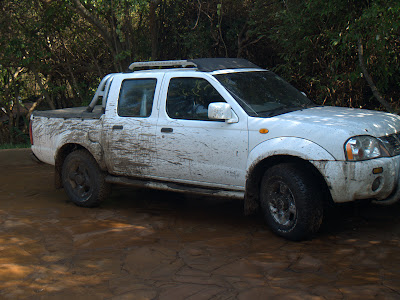
Postscript One:
The next morning as I was lying in bed reliving the events of the previous night, I was sure that I could hear our Guardian Angels complaining:
"This is not what I signed up for. I agreed to missionary protection."
"I am not trained in wild animal protection."
"I'm complaining to the Guardian Angel Supervisor. This sort of thing is not in my contract."
"My training is in city traffic and muggings. What were they thinking going out with wild animals alone?"
"They read the rules. They broke them all. Did they still expect our help?"
Postscript Two:
A few days later when we were at the Kilaguni Lodge in the Tsavo Park near our training in the Chyulu Hills, I was asked by a Safari Driver and one of the local lodge workers what had happened to my legs. (My shorts were now clean and my wounds clearly visible.) I related the above story. After completing the story and expecting to be chastised for getting out of the car near lions, the Masai safari driver said to me, "sometimes a man has to do man things!" Almost my words exactly. After all Jan is my princess, I am her knight. I had to save her. Right?




















